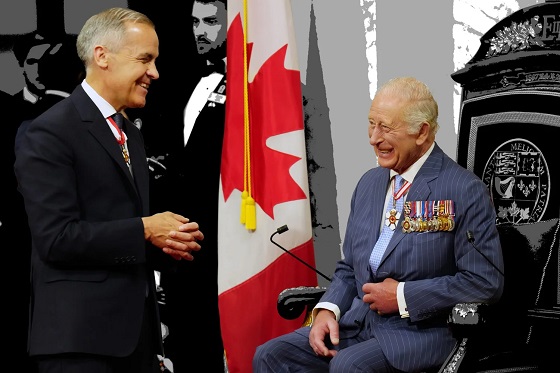Business
Canada’s struggle against transnational crime & money laundering

From the Macdonald-Laurier Institute
By Alex Dalziel and Jamie Ferrill
In this episode of the Macdonald-Laurier Institute’s Inside Policy Talks podcast, Senior Fellow and National Security Project Lead Alex Dalziel explores the underreported issue of trade-based money laundering (TBML) with Dr. Jamie Ferrill, the head of financial crime studies at Charles Sturt University in Canberra, Australia and a former Canada Border Services Agency officer.
The discussion focuses on how organized crime groups use global trade transactions to disguise illicit proceeds and the threat this presents to the Canada’s trade relationship with the US and beyond.
Definition of TBML: Trade-based money laundering disguises criminal proceeds by moving value through trade transactions instead of transferring physical cash. Criminals (usually) exploit international trade by manipulating trade documents, engaging in phantom shipping, and altering invoices to disguise illicit funds as legitimate commerce, bypassing conventional financial scrutiny. As Dr. Ferrill explains, “we have dirty money that’s been generated through things like drug trafficking, human trafficking, arms trafficking, sex trafficking, and that money needs to be cleaned in one way or another. Trade is one of the ways that that’s done.”
A Pervasive Problem: TBML is challenging to detect due to the vast scale and complexity of global trade, making it an attractive channel for organized crime groups. Although global estimates are imprecise, the Financial Action Task Force and The United Nations Office on Drugs and Crime (UNODC) suggests 2-5% of GDP could be tied to money laundering, representing trillions of dollars annually. In Canada, this could mean over $70 billion in potentially laundered funds each year. Despite the scope of TBML, Canada has seen no successful prosecutions for criminal money laundering through trade, highlighting significant gaps in identifying, investigating and prosecuting these complex cases.
Canada’s Vulnerabilities: Along with the sheer volume and complexity of global trade, Canada’s vulnerabilities stem from gaps in anti-money laundering regulation, particularly in high-risk sectors like real estate, luxury goods, and legal services, where criminals exploit weak oversight. Global trade exemplifies the vulnerabilities in oversight, where gaps and limited controls create substantial opportunities for money laundering. A lack of comprehensive export controls also limits Canada’s ability to monitor goods leaving the country effectively. Dr. Ferrill notes that “If we’re seen as this weak link in the process, that’s going to have significant implications on trade partnerships,” underscoring the potential political risks to bilateral trade if Canada fails to address these issues.
International and Private Sector Cooperation: Combating TBML effectively requires strong international cooperation, particularly between Canada and key trade partners like the U.S. The private sector—including freight forwarders, customs brokers, and financial institutions—plays a crucial role in spotting suspicious activities along the supply chain. As Dr. Ferrill emphasizes, “Canada and the U.S. can definitely work together more efficiently and effectively to share and then come up with some better strategies,” pointing to the need for increased collaboration to strengthen oversight and disrupt these transnational crime networks.
Looking to further understand the threat of transnational organized crime to Canada’s borders?
Check out Inside Policy Talks recent podcasts with Christian Leuprecht, Todd Hataley and Alan Bersin.
To learn more about Dr. Ferrill’s research on TBML, check out her chapter in Dirty Money: Financial Crime in Canada.
Business
Resurfaced Video Shows How Somali Scammers Used Day Care Centers To Scam State


From the Daily Caller News Foundation
A resurfaced 2018 video from a Minneapolis-area TV station shows how Somali scammers allegedly bilked Minnesota out of millions of dollars for services that they never provided.
Independent journalist Nick Shirley touched off a storm on social media Friday after he posted a photo of one day-care center, which displayed a banner calling it “The Greater Learing Center” on X, along with a 42-minute video that went viral showing him visiting that and other day-care centers. The surveillance video, which aired on Fox 9 in 2018 after being taken in 2015, showed parents taking kids into the center, then leaving with them minutes later, according to Fox News.
“They were billing too much, they went up to high,” Hennepin County attorney Mike Freeman told Fox 9 in 2018. “It’s hard to imagine they were serving that many people. Frankly if you’re going to cheat, cheat little, because if you cheat big, you’re going to get caught.”
Dear Readers:
As a nonprofit, we are dependent on the generosity of our readers.
Please consider making a small donation of any amount here.
Thank you!
Democratic Gov. Tim Walz of Minnesota was accused of engaging in “systemic” retaliation against whistleblowers in a Nov. 30 statement by state employees. Assistant United States Attorney Joe Thompson announced on Dec. 18 that the amount of suspected fraud in Minnesota’s Medicaid program had reached over $9 billion.
After Shirley’s video went viral, FBI Director Kash Patel announced the agency was already sending additional resources in a Sunday post on X, citing the case surrounding Feeding Our Future, which at one point accused the Minnesota government of racism during litigation over the suspension of funds after earlier allegations of fraud.
KSTP reported that the Quality Learning Center, one of the centers visited by Shirley, had 95 citations for violations from one Minnesota agency between 2019 to 2023.
President Donald Trump announced in a Nov. 21 post on Truth Social that he would end “Temporary Protected Status” for Somalis in the state in response to allegations of welfare fraud and said that the influx of refugees had “destroyed our country.”
Business
Disclosures reveal Minnesota politician’s husband’s companies surged thousands-fold amid Somali fraud crisis

Rep. Ilhan Omar’s latest financial disclosures reveal seemingly sudden wealth accumulation inside her household, even as Minnesota grapples with revelations of massive fraud that may have siphoned more than $9 billion from government programs. The numbers, drawn from publicly filed congressional reports, show two companies tied to Omar’s husband, Tim Mynett, surging in value at a pace that raises more questions than answers.
According to the filings, Rose Lake Capital LLC — a business advisory firm Mynett co-founded in 2022 — jumped from an assessed range of $1 to $1,000 in 2023 to between $5 million and $25 million in 2024. Even using the most conservative assumptions allowed under Congress’ broad valuation ranges, the company’s value would have increased thousands of times in a single year. The firm advertises itself as a facilitator of “deal-making, mergers and acquisitions, banking, politics and diplomacy.”
Archived versions of Rose Lake’s website once showcased an eye-catching lineup of political heavyweights: former Ambassador to Bahrain Adam Ereli, former Sen. Max Baucus, and prominent Democratic National Committee alumni William Derrough and Alex Hoffman. But as scrutiny surrounding Omar intensifies — particularly over whether her political network intersected with sprawling fraud schemes exposed in Minnesota — the company has quietly scrubbed its online footprint. Names and biographies of team members have vanished, and the firm has not clarified whether these figures remain involved. Omar’s office offered no comment when asked to explain the company’s sudden growth or the removal of its personnel listings.
Mynett, Omar’s third husband, has long been a controversial presence in her political orbit, but the dramatic swell in his business holdings comes at a moment when trust in Minnesota’s oversight systems is already badly shaken. Federal and state investigators now estimate that fraud involving pandemic-era and nonprofit programs may exceed $9 billion, a staggering figure for a state often held up as a model of progressive governance. For many residents, the revelation that Omar’s household wealth soared during the same period only deepens skepticism about who benefited from Minnesota’s expansive social-spending apparatus.
The financial story doesn’t stop with Rose Lake. A second Mynett-linked entity, ESTCRU LLC — a boutique winery registered in Santa Rosa, California — reported an assessed value of $1 million to $5 million in 2024. Just a year earlier, Omar disclosed its worth at $15,000 to $50,000. Despite the dramatic valuation spike, ESTCRU’s online storefront does not appear to function, its last social media activity dates back to early 2023, and the phone number listed on its website is no longer in service. As with Rose Lake, Omar’s office declined to comment on the winery’s sudden rise in reported value.
The House clerk has yet to release 2025 disclosures, leaving unanswered how these companies are performing today — and how such explosive growth materialized in the first place.
-

 Business7 hours ago
Business7 hours agoICYMI: Largest fraud in US history? Independent Journalist visits numerous daycare centres with no children, revealing massive scam
-

 Daily Caller1 day ago
Daily Caller1 day agoWhile Western Nations Cling to Energy Transition, Pragmatic Nations Produce Energy and Wealth
-

 Daily Caller1 day ago
Daily Caller1 day agoUS Halts Construction of Five Offshore Wind Projects Due To National Security
-

 Alberta2 days ago
Alberta2 days agoAlberta Next Panel calls for less Ottawa—and it could pay off
-

 Bruce Dowbiggin1 day ago
Bruce Dowbiggin1 day agoBe Careful What You Wish For In 2026: Mark Carney With A Majority
-

 Energy2 days ago
Energy2 days agoWhy Japan wants Western Canadian LNG
-

 Business2 days ago
Business2 days agoLand use will be British Columbia’s biggest issue in 2026
-

 Business2 days ago
Business2 days agoMainstream media missing in action as YouTuber blows lid off massive taxpayer fraud






